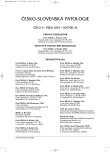The Most Recent Knowledge on the Theory of Genesis of Diffuse Axonal Injury of the Brain
Nejnovější náhledy na teorii vzniku difuzního axonálního poškození mozku
Obsahem sdělení je přehled nejnovějších poznatků, týkajících se patofyziologie traumatického axonálního postižení a z toho vyplývajících forenzních a klinických implikací. Oproti mechanistické představě je zdůrazněna dynamická kaskáda biochemických pochodů na subcelulární úrovni, ve svém konečném důsledku vedoucím k axonotmesi. Diskutovány jsou i možnosti zásahu do této kaskády, především pokud se týče toxických látek. V závěru je zdůrazněna nutnost zohlednění těchto poznatků v znalecké činnosti.
Klíčová slova:
difuzní axonální poškození – trauma hlavy
Authors:
M. Hirt 1; Z. Novák 2
Authors‘ workplace:
Lékařská fakulta Masarykovy univerzity v Brně a Fakultní nemocnice u sv. Anny, Brno
; Ústav soudního lékařství
1; Neurochirurgická klinika
2
Published in:
Soud Lék., 52, 2007, No. 4, p. 57-59
Overview
The paper presents the most recent knowledge related to the patophysiology of traumatic axonal injury and resulting forensic and clinical implications. The mechanistic idea is replaced by the idea of dynamic cascade of biochemical events on subcellular level, finally leading to axonotmesis. Interventions targeted to the cascade are discussed with respect to toxic drugs. Finally a necessity to consider the new knowledge in forensic problems is outlined.
Key words:
axonal injury – head trauma
Labels
Anatomical pathology Forensic medical examiner ToxicologyArticle was published in
Forensic Medicine

2007 Issue 4
Most read in this issue
- Post Mortem Cooling of the Body and Estimation of Time Since Death
- The Most Recent Knowledge on the Theory of Genesis of Diffuse Axonal Injury of the Brain
- Contents of Pentosidine in the Tissue of the Intervertebral Disc as an Indicator of the Human Age
